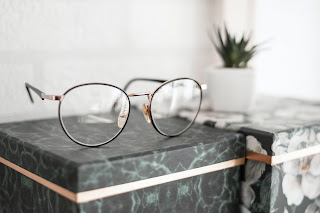Progressive glasses - clarity of sight at any distance
How do you read at a distance? Do you slide your glasses over your forehead or the tip of your nose and look at nearby objects without them? Or do you carry two pairs of glasses with you - one for on-the-street use and one for in-store shopping?
 |
| Photo by Dominika Roseclay: Pexels.com |
Presbyopia or "old-sightedness," usually occurs after the age of 40. People suffering from presbyopia keep the object of the activity away from their eyes. It can make it difficult to read books, check messages on a phone or file nails with a nail file.
They have to change their glasses depending on how far they are looking. For example, to check the timetable at a stop, they remove the "minuses" and put the "pluses" in.
Instead of two pairs of glasses - progressive glasses
New technologies make it possible to incorporate different powers in one lens. They are glasses that allow you to see smoothly and clearly at any distance. These are glasses with progressive lenses - they are ideal for reading and looking at objects at intermediate or distance distances up close.
Progressive glasses are equipped with special lenses with areas of different power. In the upper part of each lens there is a zone with a negative diopter value: for distance, and in the lower part with power - for near, e.g. for reading. Between them and on the sides there is a progression zone with smoothly changing powers. The lens constructed in this way provides a clear image regardless of the distance. The transition between the zones is physiological for the eyes, so a person who permanently wore "minuses" and used reading glasses has to get used to the new lenses.
How to look through progressive glasses?
To see clearly through progressive glasses, you need to tilt, tilt or raise your head, or turn it sideways. Adaptation to progressive glasses takes from a few hours to 2-3 days. Instead of constantly changing two pairs of glasses, only use one and see clearly at any distance.
Who can wear progressive glasses?
Progressive glasses are usually worn by people over 40 years of age and older. They are made to individual order, so are ideally suited to individual vision parameters.
Progressive glasses should not be worn by people who have strabismus, labyrinth or binocular vision disorders, or macular degeneration. It is not recommended to "progress" also when diagnosed with eye diseases, such as glaucoma or cataracts.
How to change to progressive glasses?
After the age of 40, consider changing to progressive glasses. Of course, you must first comprehensively examine your eyesight. This can be done by an optometrist. However, when the vision defect has increased significantly in a short time, it will be necessary to consult an ophthalmologist.
It's worth telling the optician right away that we are going to be wearing progressive glasses.
It is also important to choose the right progressive lenses, depending on how the person uses their eyesight. Therefore, a good optometrist, in addition to the examination, always conducts an interview: he asks about visual activity during the day, week or month.


Comments
Post a Comment